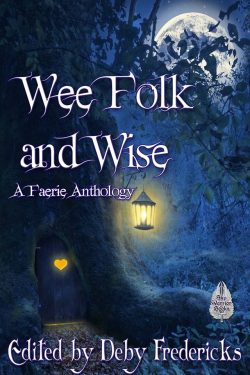This guest post is brought to you by Deby Fredericks, whose blog Wyrmflight has taught me many an interesting dragon-related fact and myth. She recently edited an anthology of fairy and folk tale-inspired stories called Wee Folk and Wise, and has shared some reflections from Matthew Timmins, one of the collection’s contributors, on the age-old appeal of fairy tales:
Why I Write Fairy Tales
by Matthew Timmins
With a story in the Wee Folk and Wise anthology, I thought it might be time to explain why I, an adult man in the 21st Century, write fairy tales. To begin with a common assumption, I do not write them for children. Children are certainly welcome to read my fairy stories and I hope they will enjoy them, but they are not directed toward them (whatever that would mean). But neither are they “adult” fairy tales, full of sex-starved sprites, ultra-violent knights, or even wry commentary on the state of the world. No, I prefer to write the traditional once-upon-a-time, happily-ever-after fairy tales (with perhaps a bit of the mock-heroic thrown in).
“Once upon a time” is a magical opening, a kind of incantation, that ushers us into a land far away from everything we know and yet ancestrally familiar. Like a dream, we seem to know the rules of fairy tales even if we cannot always explain them: things come in threes, you mustn’t stray from the path, youngest children have all the luck, etc. But even with all their common themes and elements, fairy tales aren’t formulaic. They are rhythmic, like music. The rising and falling notes are no less welcome for being anticipated.
And though their lessons are sometimes dubious (it’s okay to deceive, rob, cheat, and murder your enemies), fairy tales are ultimately moral stories. Justice is a force of nature, Good is rewarded and Evil punished (albeit not always swiftly or proportionally). And despite the trickery of some of their protagonists, the tales themselves are trustworthy. When the storyteller tells you that a young lass is “clever and good” or the old queen is “as wicked as winter” you can confidently expect cunning rescues from the former and evil plots from the latter. For there is a certain distance from these characters. They are not given internal monologues or introspection. Yet there is also an immediacy to their actions, a straightforwardness, that gives these stories a kind of instinctive simplicity.
This is what fairy tales offer: strangeness, familiarity, simplicity, truth, beauty. When I read fairy tales, I am reading odd chapters in a story that started centuries ago and will never end. When I write fairy tales, I am writing in a language shared by a million storytellers, full of folk magic, old lessons, deep desires, and primal fears. That’s why I write fairy tales, to sing – if I can – a few verses of that old, old tune that we all know, even if I have to make up the words.
_________
 Matthew’s tale in the anthology is titled “Gog from Magog” and tells the story of a giant who falls in love with a fairy. If you’d like to read it, and the many other stories in the Wee Folk and Wise collection, you can get a copy here.
Matthew’s tale in the anthology is titled “Gog from Magog” and tells the story of a giant who falls in love with a fairy. If you’d like to read it, and the many other stories in the Wee Folk and Wise collection, you can get a copy here.

Interesting post!
LikeLiked by 2 people
Thanks, Matthew’s story is great!
LikeLiked by 3 people
It’s got an intriguing premise too – I’ve never read a story about a giant and a fairy falling in love, but the idea appeals to me!
LikeLiked by 2 people
Thanks! If you want to read more of my fairy tales, visit me at:
http://www.majtimmins.com/short-stories.html
LikeLiked by 2 people
You’re welcome! Thanks- I will check it out 🙂
LikeLike
Pingback: AMAZING NEWS: March 24, 2019 - Amazing Stories